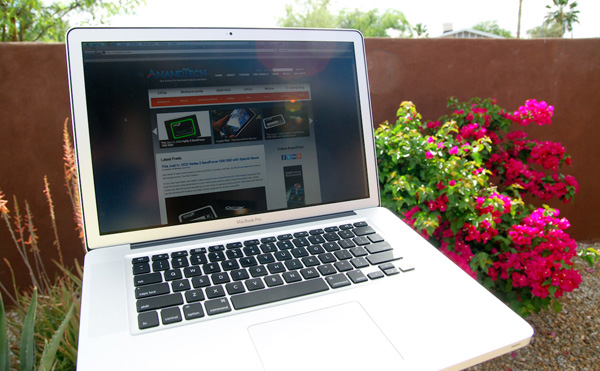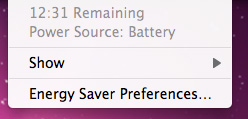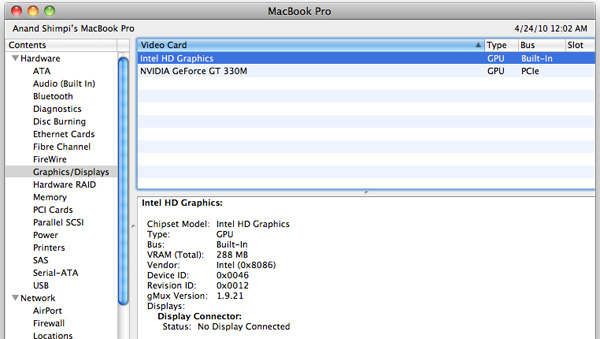Apple's 15-inch 2010 MacBook Pro: More Battery Life Tests, High Res Display Evaluated
by Anand Lal Shimpi on April 24, 2010 1:57 AM EST- Posted in
- Mac
- Displays
- MacBook Pro
- Arrandale
- Laptops
Apple is in a position that’s enviable by any consumer facing company. It drums up genuine excitement for nearly every product it launches. Apple has somehow found a way to make something as small as just another processor refresh exciting.
It’s not all smoke and mirrors though. The previous generation unibody MacBook Pro posted some incredible battery life numbers. And two weeks ago Apple paired it with Intel’s Core i5 and i7 mobile CPUs, delivering the sort of desktop-like performance we’ve been waiting for.

Since the release we’ve had the time to answer a few more questions about the new systems. We updated our launch article with Core i5 vs. Core i7 results. But today, in response to many of your requests, we’ve got more battery life results and a full evaluation of the 15-inch MacBook Pro’s display quality. Apple is often the go-to manufacturer for creative professionals, we put our colorimeter on the MacBook Pro to find out if they’re making the right choice.
Battery Life: Better and Worse in the Real World
Battery life on the new MacBook Pro is a lot more varied than it was on the old one. While our light web browsing test does a good job of showing you what very light usage can give you, I find that the new 15-inch MacBook Pro spends more time at states of higher power draw than the old one. This is difficult to show as a single benchmark result but it appears to be because of two things.

The obvious cause is that the Core i5/i7 CPUs let you do more with the machine. Tasks complete quicker, the system is more responsive and as a result you end up doing more with the machine.
The second part of the problem is Apple’s automatic graphics switching technology. While it relies on applications that use specific frameworks (e.g. OpenGL, OpenCL, Quartz Composer, Core Animation and Core Graphics), many have pointed out strange behavior when doing something as harmless as browsing the web.
An attentive Mac Rumors reader pointed out that by looking at OS X’s System Profiler you can find out what GPU is being used: the active GPU will list the specs of the display it’s driving:

The inactive GPU will simply state that there’s “No Display Connected”. Start up Photoshop and you’ll see the discrete GPU kick in, close it and you’ll see Intel’s HD Graphics take over.

Readers of my first Month with a Mac article will know that one thing I quickly embraced about OS X was the idea of just leaving applications open. If you’ve got enough memory, OS X tends to do just fine with a ton of applications open. In fact, the UI is designed around it; closing all application windows rarely quits the app itself, Apple appears to want you to leave your frequently used apps open and idle. It makes switching between them that much faster. The fact that the new MacBook Pro’s discrete GPU won’t power down if you have an application like Photoshop open flies in the face of this leave-your-apps-open usage model.
So you’ve got to be mindful of what applications will trigger the discrete GPU to take over. That’s not terribly hard, but there’s just one problem: sometimes your web browser can wake up the dGPU. I’ve found numerous cases where Google Chrome will activate the discrete GPU, while our own Brian Klug found that Firefox did the same. I haven’t extensively tested Safari to see if it has the same issue. I suspect this is a software bug, but it is one that lowers battery life in real world usage scenarios. The discrete GPU remains powered down in all of my OS X battery life tests, but I found that in my using the new MacBook Pro my battery ran down much quicker than I was expecting. Part of it is the potentially more power hungry Arrandale CPU, but part of it is the fact that the discrete GPU was active when it had no reason to be.
You’ll still get better battery life compared to an older MacBook Pro, and you have the potential to get better battery life than last year’s 2nd gen unibody MacBook Pro. But as I mentioned in our review, there’s also the chance that you’ll see lower battery life than the previous model. And as I’ve come to realize, that chance is higher than I originally thought because of the issues mentioned above. It's even higher if you opt for the Core i7 model...










69 Comments
View All Comments
ltcommanderdata - Saturday, April 24, 2010 - link
It's kind of disappointing that the Core i7 takes a noticeable battery life hit compared to the Core i5 considering they both in the same 35W TDP target. Could you double check the clock speeds of the GPU in the Core i7 model? The low-end Core i5 model you previously showed a GPU-Z shot of was definitely underclocked, but perhaps that's because it's replacing the previous pure 9400M model, whereas higher model MacBook Pros might have higher clock speeds which could help explain the battery life difference.As well, since you have Windows installed on the MacBook Pros, could you do your round of mid-range laptop gaming comparison benchmarks as was done for the ASUS G73Jh? People don't buy MacBook Pros specifically to game, but people with MacBook Pros no doubt do play games, so I think it'll be useful information. Running it against the Mid-2009 17" MacBook Pro you have would also be good to see the improvement of the GT330M over the 9600M GT.
I'm also curious to see if the limited thermal room of the MacBook Pro limits the effectiveness of Turbo Boost. It might be interesting to chart the CPU frequency of the Core i7 over an hour as it cycles through an intensive benchmark to see if it can hit the top Turbo Boost bin (3 bins for 2 cores) and how long it can sustain that before the heat sinks saturate and the clock drops back down to normal. Of course, without comparison to other laptops with more thermal room, it's hard to tell the "normal" or optimal Turbo Boost behaviour of the Core i7, but it should be something manufacturers should consider to differentiate themselves from others using the same components.
aj28 - Saturday, April 24, 2010 - link
Anand,Pardon if you've already covered this and I missed it, but have you done any tests comparing the effects on battery life by the use of Flash 10.1 versus Flash 10.0 on any of the Apple/Optimus GPU-switching i5/i7 notebooks? If Flash 10.1 kicks on the dGPU, is there a chance that the i5 might be able to power through it with ease to the point that you could actually get better battery life by not using GPU acceleration?
I know that goes against common wisdom, and I'm sure you would be better off if we were talking about a low-power integrated chip, but it seems to me that the mid-to-high-end dGPU chips are horribly inefficient for this type of thing in cases like these where they can, unlike a desktop, simply be switched off completely in favor of an iGPU which has to be powered all the time anyway, even if in a low-power state.
Thanks for your reply if you get around to it!
flgt - Saturday, April 24, 2010 - link
I think you've already stated why they won't put much effort in OS X. It's a huge population of STUDENTS. And students don't generate revenue like fat corporate and government accounts.I’m sure the Mathworks don’t want to artificially limit their customer base, but if it is coming down to a decision between OS X or Windows/Linux it’s obvious which one will take priority.
For the vast amount of companies Windows and Linux deliver equivalent or better hardware at much better price points. They also host more of the client applications that drive productivity, which could be argued to be more important than the OS itself.
You could argue it is important to reach students who one day might be paying corporate users, but if a student learns MATLAB on their Mac they can easily be just as productive on a corporate PC. There is no real incentive to make the experience better for a minority of non-paying users.
mbene12 - Sunday, April 25, 2010 - link
I know it is totally off topic, but this is exactly why I left Matlab for python. Their lack of native Mac support. As I transitioned from student to professional I just didnt see a reason to pay $4000 a year for base license and libraries which performed poorly when I could get most of what I needed done in a mix of Python and C for free.erple2 - Monday, April 26, 2010 - link
I think that thinking is a double edged sword. Students (and more importantly, Universities) are a major piece of the Matlab licensing revenue. I know that the Educational discount is pretty decent, but that's still a significant chunk of change. I'd wager that if you looked at the total number of licenses the Mathworks distribute, Education would be an even player with Corporate and Government levels.The other argument (that you can get more hardware for the money) has (almost) always been the case with Apple, however. There were a few notable exceptions (Apple had the first Core2 based desktops and laptops - I can't remember if they were on the forefront with the i7 based desktops, though), plus when DDR3 first came out in a SODIMM format, Apple was curiously reasonably priced.
rawd - Saturday, April 24, 2010 - link
Hi Anand, Cody Kreiger on Macrumors has already written an app to monitor GPU usage and it resides in the taskbarhttp://codykrieger.com/gfxCardStatus.app.zip
bitninja - Saturday, April 24, 2010 - link
Thanks for the mention rawd! Anyone interested in seeing the MacRumors forum thread where it's being discussed and fleshed out can visit it below until I get a formal page up on my website:http://forums.macrumors.com/showthread.php?t=90152...
Thanks, be sure to leave a comment with your thoughts if you try it out!
Cody
rcocchiararo - Saturday, April 24, 2010 - link
Is it posible to get a 15 inches macbook pro with a glossy/matte high res display from, lets say.. amazon/bestbuy/newegg/whatever ?or only directly from apple ?
Computer Scooter Joe - Saturday, April 24, 2010 - link
Thanks for the info, just one more question. Do the fans spin up as a result of the dGPU being on? Or are they generally fairly quiet?I understand that it depends on the application, but im talking about just idiling at desktop or web browsing or working in Word.
maxxl - Saturday, April 24, 2010 - link
I can't post this command here unfortunately, becouse of an error that appears when I try to, so look at this thread for "ioreg -lw0" command:http://discussions.info.apple.com/message.jspa?mes...
With the model number you can find manufacturer easily, i.e. here:
http://www.beyondinfinite.com/library.html
Best reards,
Max